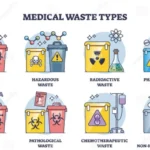Medical Waste Classification (ABCDE) and the Role of HICLOVER Incinerators
In the field of healthcare waste management, the “ABCDE classification” is widely used to define the categories of medical waste. This system is followed in China and adopted in several African and Asian countries with slight variations. Understanding these categories is essential for selecting the right medical waste incineration system, such as those offered by HICLOVER, to ensure safe, compliant, and efficient treatment.
The Five Categories of Medical Waste
A – Infectious Waste
This includes materials contaminated with pathogens from the treatment of infectious patients. Typical examples are gauze, cotton swabs, disposable protective gear such as gloves and masks, and discarded culture dishes or liquids from laboratories.
B – Pathological Waste
Consists of human tissues, organs, and body parts generated from surgeries or autopsies, as well as animal carcasses, organs, and pathological specimens used in laboratory testing.
C – Sharps Waste
Covers discarded needles, syringes, scalpels, glass slides, test tubes, and ampoules. These are usually collected in designated sharps containers but must undergo incineration for complete destruction.
D – Pharmaceutical Waste
Includes expired, unused, or contaminated drugs, vaccines, antibiotics, and chemotherapy residues. This category requires high-temperature incineration to ensure safe neutralization of chemical compounds.
E – Chemical Waste
Made up of toxic, corrosive, flammable, or explosive chemicals, laboratory reagents, heavy metal-containing thermometers, and discarded developers from imaging processes.
Are There F and G Categories?
Formally, the medical waste classification is limited to A–E categories. However, some regions have expanded classifications to include:
-
F – Heavy Metal Waste (such as mercury-containing devices).
-
G – Pressurized Containers (like oxygen cylinders or aerosol cans).
These extensions are not universal standards and are rarely applied in international guidelines. For example, the WHO and World Bank projects usually classify waste into Infectious, Sharps, Pharmaceutical, Chemical, and sometimes Radioactive.
HICLOVER Incinerators and Waste Category Compatibility
HICLOVER designs and manufactures high-temperature dual-chamber medical waste incinerators that are specifically built to handle the challenges of ABCDE waste streams:
-
Infectious and Pathological Waste (A & B): HICLOVER incinerators operate with primary chamber temperatures of 850–1000°C and secondary chamber temperatures of 1100–1300°C with a minimum 2-second retention time, ensuring complete sterilization and destruction of pathogens.
-
Sharps Waste (C): The robust refractory-lined chambers reduce sharps to sterile ash, preventing reuse and eliminating risks of injury or infection.
-
Pharmaceutical and Chemical Waste (D & E): With options for wet scrubbers, dry scrubbers, and activated carbon systems, HICLOVER equipment provides reliable solutions to neutralize hazardous chemical emissions and reduce dioxins and furans to international compliance levels.
-
Heavy Metals and Special Waste (F & G): While mercury thermometers, radioactive isotopes, or gas cylinders are not recommended for direct incineration, HICLOVER systems can be integrated into broader waste management frameworks where such materials are separated before treatment.
Why HICLOVER?
-
Refractory Technology – High alumina refractory brick with 65% Al₂O₃ ensures chamber durability against extreme thermal and chemical stresses.
-
PLC Automation – Fully automated systems with sensors, alarms, and real-time monitoring guarantee operational safety and fuel efficiency.
-
Scalable Solutions – From TS30 PLC models for small clinics to containerized TS200 and TS300 units for large hospitals and donor-funded projects, HICLOVER provides tailored solutions for diverse healthcare facilities.
-
International Compliance – Designed in line with WHO guidelines, EU Waste Incineration Directive, and GB18484-2020 standards, ensuring environmental safety in Rwanda, Tanzania, and other African markets.
Conclusion
The ABCDE medical waste classification provides the foundation for safe healthcare waste disposal worldwide. With its advanced design and proven track record, HICLOVER incineration systems offer reliable solutions for treating infectious, pathological, sharps, pharmaceutical, and chemical wastes. By integrating optional emission control systems, HICLOVER ensures compliance with strict environmental standards, making it an ideal partner for hospitals, clinics, and international aid projects in Rwanda and across Africa.


Comments are closed